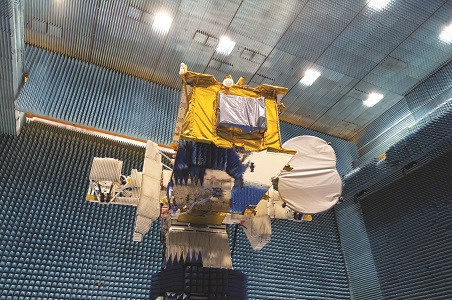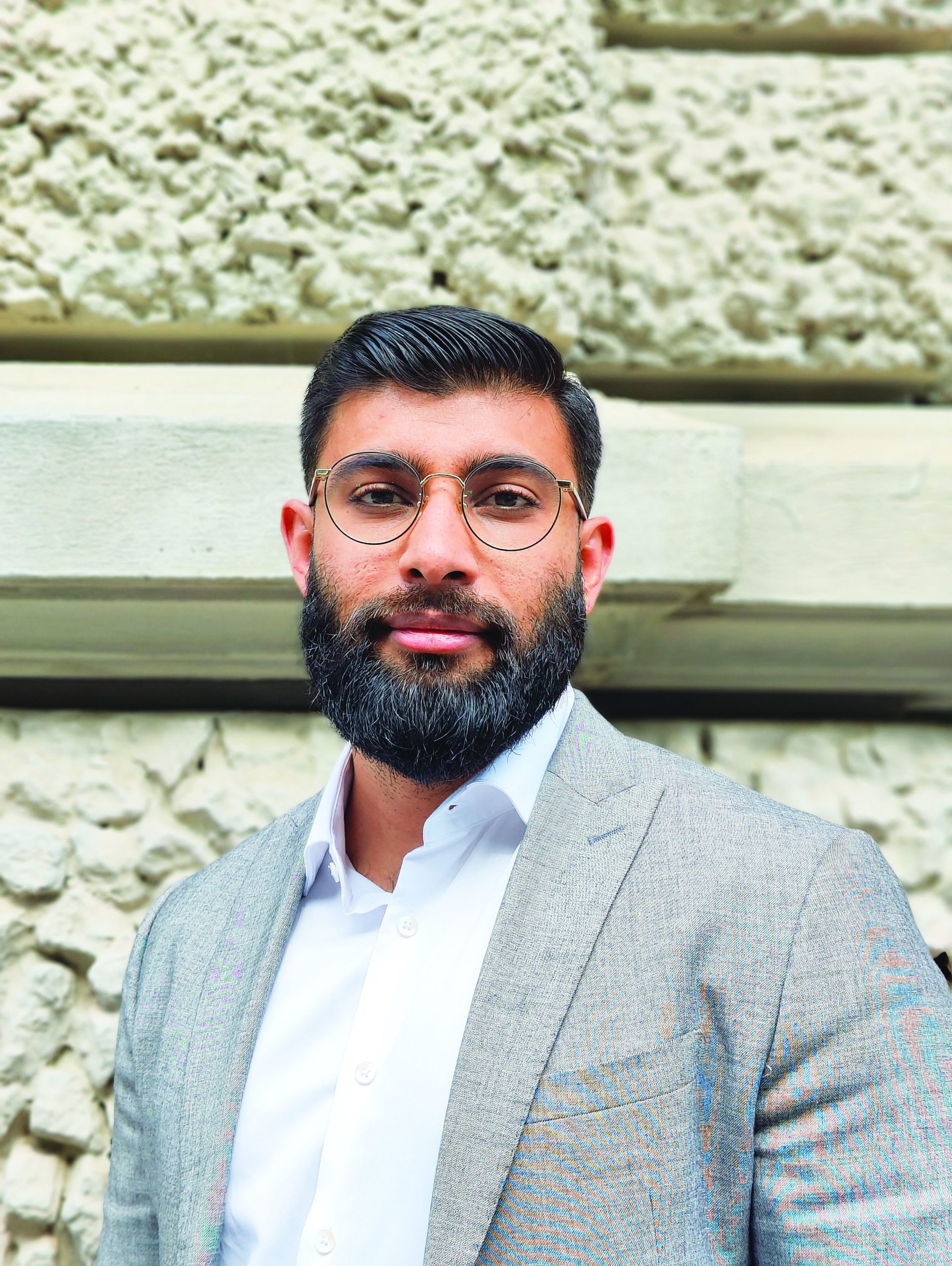 The world’s first satellite that can be fully reprogrammed while in orbit has already been in operation for more than a year. Now industry insiders believe such flexible missions could soon become the industry standard. Eutelsat Quantum, launched from French Guiana last summer, is the first commercial Ku-band satellite to have a fully flexible payload that can be remotely configured by software from end-users’ premises – all while in orbit 36,000km above Earth.
The world’s first satellite that can be fully reprogrammed while in orbit has already been in operation for more than a year. Now industry insiders believe such flexible missions could soon become the industry standard. Eutelsat Quantum, launched from French Guiana last summer, is the first commercial Ku-band satellite to have a fully flexible payload that can be remotely configured by software from end-users’ premises – all while in orbit 36,000km above Earth.
Thanks to adjustable antennas, reconfigurable transmission beams and customised electronics, the Quantum can respond to changing demands for data transmission and secure communications in near-real time, repeatedly over its expected 15-year lifespan.
For example, communications channels can be redirected within minutes to reach passengers aboard moving planes, ships, trucks and cars. At the same time, the Quantum’s beams also can be easily adjusted to deliver more data when demand surges, an Eutelsat spokesperson says. Power allocation and carrier frequency management can similarly be defined and modified on the go.
Changes can be carried out either by Eutelsat as the satellite operator, or by government and defence users opting to independently and securely control their portion of the payload.
The Quantum represents a new breed of software-defined satellites (SDS) that is being positioned as an industry game changer. As customer demand for satellite services changes and capacity needs expand, the industry is responding by transitioning to software-focused units.
Traditionally, satellites have been preconfigured and assembled to carry out specific tasks in predetermined markets. By contrast, SDS units pair standardised hardware with adjustable software programmes that can be altered while in orbit. New programs can be uploaded from the ground at any time, and only the data of interest downlinked. Consequently, operators can quickly pivot to shifts in the business landscape without having to build and deploy another unit.

For a rather simplified comparison, consider software-defined satellites like a smartphone whose operating system is constantly being upgraded to perform new tasks (including security enhancements).
Given the sector’s long timeframes from construction to launch, switching to flexible, software-defined operations helps extend a satellite’s lifecycle and improve environmental sustainability, says Dr Sean Shan Min Swei of the UAE’s Khalifa University. The former NASA research scientist is Professor of Practice, Acting Chair of Aerospace Engineering, and Director of the university’s Space Technology and Innovation Center.
He says the ability to upload, reformulate, reformat, reinstall new functionalities and tailor operations to changing needs is becoming critical to satellite operations. “The idea of flexibility or flexible reconfiguration, which has been called software-defined, is now going to be a starting point for every new industry development. While there are many unknowns, over time this is going to become the norm,” Dr Swei says.
Among SDS units’ main benefits are flexibility. “From an operator standpoint, you gain the ability to change your mission. That’s one of the hardest things about space: once you launch a satellite, your mission is defined for the next five to 15 years. You can change some of its functionality, but really, your mission is well defined. Having an SDS means that you can potentially change that,” says Dallas Kasaboski, Principal Analyst at industry market research and consulting firm NSR and a co-author of the firm’s recent Software-Defined Satellites report.

Eutelsat Quantum
Operators can respond to slow-changing needs like business models and customer demographics, to fast-changing needs like moving bandwidth and power around to support the new traffic across a region. In most cases, they can be reconfigured within a few minutes to respond to fluctuations in customer or network demand or to weather conditions, signal interference or other circumstances.
Revenue opportunity
The growing SDS market indicates an $86.9 bn cumulative revenue opportunity from launch and manufacturing operations between 2020 and 2030, NSR estimates.
“Embracing innovations such as software-defined platforms allow operators to enable new business cases and growth opportunities,” says Hussain Bokhari, NSR Senior Analyst, and a co-author of the firm’s recent SDS report. “With enhanced offerings to customers through flexibility options, businesses could minimise CAPEX and increase profits over the satellite life cycle.”
Prime manufacturers focused on or offering flexible SDS options include major names such as Airbus, Lockheed Martin, Thales Alenia Space and Boeing, according to NSR. Kasaboski adds: “We’re also seeing some development from what we call in-house, where operators are developing their own satellites, and they are developing some level of flexibility – such as Amazon, SpaceX, Telesat, which have either partial or potentially fully flexible second-generation offerings.”

Full software definition is still some distance away. The analysts expect to see an industry shift over the next three to five years. “After about three to five years, we expect the pricing to be better understood, the offerings to be more standardised, and to have some flight experience. And then the necessity of the market will drive flexibility, whether operators are hesitant or not, and they’ll be able to reach those needs,” Kasaboski says.
Beyond flexibility and sustainability, price will be a major driver for the switch. As hardware becomes standardised, it drives down manufacturing costs and SDS units can therefore be cheaper than some bent-pipe offerings, he adds.
For now, non-GEO-HTS constellation satellites will lead the uptake with 95% demonstrating full or partial flexibility as software-defined platforms by 2030. However, with testing still in progress, operator hesitancy sees only 70% of GEO satellite orders to capture this trend in the medium term, NSR forecasts. Most non-GEO constellation satellites will feature some, but not all of the capabilities of a fully software-defined system, while GEO operators evaluate business potential, notes Kasaboski.
Early movers
Inmarsat has been one of the early movers in the SDS space, partnering with Airbus OneSat in 2019 to enhance its Global Express (GX) Ka-band network with an order for three satellites. The GX7, 8 and 9 are due to be launched in 2024. Each powers around twice the total capacity of the entire mobile broadband GX network at present.
“These satellites allow coverage, beams, power and bandwidth to be optimised and changed in realtime, delivering capacity where and when the customers need it. This is particularly important for mobility, which has variable demands, such as time of day, hotspots, flight routes, etc. This optimises the use of the payload, as no capacity is left stranded where there is no demand. This is wholly unlike a LEO mega-constellation which has the same amount of capacity over a hotspot as over empty oceans. This pushes the ‘fill rate’ or efficiency of the satellite to close to 100% and lowers the cost per used bit,” says Mark Dickinson, Vice President, Space Segment at Inmarsat. “As these SDSs are generic designs, rather than designed for a specific mission, they can be produced via a production-line approach and hence should reduce the time from order to operations.”
 Elsewhere, Thales Alenia Space has been developing Space Inspire (INstant SPace In-orbit REconfiguration), with a view to delivering a fully flexible SDS solution that allows for seamless telecommunication mission and services reconfiguration, instant in-orbit adjustment to the demand and complete flexibility for video broadcasting and broadband connectivity services while maximising the efficiency and use of the satellite’s resources.
Elsewhere, Thales Alenia Space has been developing Space Inspire (INstant SPace In-orbit REconfiguration), with a view to delivering a fully flexible SDS solution that allows for seamless telecommunication mission and services reconfiguration, instant in-orbit adjustment to the demand and complete flexibility for video broadcasting and broadband connectivity services while maximising the efficiency and use of the satellite’s resources.
“Space Inspire is opening a new area for telecom served through GEO in line with global uncertainties and challenges, thanks to the benefits of a deep digital transformation without security or operability concessions,” says Bernard Jacqué, Constellations Solutions Product Line Director at Thales Alenia Space.
He says the trend is a response to changing consumer behaviour as the world transitions to what he calls a VUCA environment, i.e. one that is volatile, uncertain, complex and ambiguous. “Consumers are asking for more and more connectivity of high quality with more and more video content for leisure, for working, for learning, for buying. This connectivity is needed everywhere and at any time. It is a generational trend. Less and less people are spending time in front of their TV screens,” he says. Like other developments in advanced technology, the trend has been accelerated both by the effects of the pandemic and recent geopolitical developments, he adds.
Satcom operators must deal with uncertainties such as an unpredictable rate of transition, enhanced consumer mobility, and ever-changing rules and regulations, he says. Operators can respond by transitioning from broadcast to broadband, providing consumers with connectivity wherever they are: at home, for an enterprise, or in motion, whether on a plane, an automobile or a cruise.
Jacqué says that the impact of SDS is already visible. “Most GEO contracts awarded over the last two years are SDS, demonstrating that SDS is a highly valuable proposition for GEO to complement LEO and MEO projects and to best face future challenges.”

Ground developments
But for all their enhanced bandwidth, capabilities, and flexibility, SDS units are wasted if ground systems do not advance to enable those capabilities.
“Traditionally, the ground segment and satellites have been viewed as separate, with the satellite functioning as a fixed ‘bent pipe,’ but with software-defined payloads they need to operate as one synchronised system. For that, the ground needs to change by transitioning from closed, manually controlled hardware, to open, flexible, automated software to match the capabilities and flexibility of the satellites. This involves converting analogue radio-frequency signals to digital packets, virtualising hardware to software, and automating as many processes as possible. With digitised satellite signals and virtualised signal processing, the ground can now operate much more flexibly so operators can maximise the value of these software-defined payloads,” says Stuart Daughtridge, who, as Vice President of Advanced Technology for Kratos, leads the company’s ground segment technology initiatives including the planning for the next generation of ground technology.
Cue greater importance for the ground segment in an SDS world. “Together, the SDS and ground can now operate in tandem as a real-time integrated system, driving coordinated change to instantiate services in minutes – not the hours, days or weeks in traditional systems. Operators can provision more quickly and flexibly, spinning services up and down elastically on-demand in software, driving down the cost per bit,” Daughtridge adds. “Software-defined payloads can provide far more value if they can be more tightly integrated with larger terrestrial networks, which a more dynamic ground enables to further drive growth.”

Challenges ahead
Yet, a number of challenges must be addressed before SDS units can truly become the game-changers they are positioned as.
First, with the industry being at the earlier stages of digital transformation and SDS units still being tested, many operators are still in the assessment phase. And development timelines mean an SDS may not be available in time for operators to meet customer requirements.
Kasaboski recounts the case of an operator who had ordered an SDS to replace a failing satellite. However, they ultimately reverted to a traditional bentpipe satellite. “The timeline was faster. They needed that satellite replaced within the next two years. And the order-to-launch window was shorter for a bent pipe,” he says. “So, the challenge is meeting the customer’s needs, actually interfacing with market integration, and not just responding to pure technological developments.”
Again, the ground segment remains crucial. “One main challenge with SDS units is you have this really flexible satellite that’s actually more flexible than the ground network. And so, it doesn’t matter how flexible your satellite is, if your ground network can’t keep up, it is the limiting factor,” he says.

Kratos’ Daughtridge points to the need for common standards. For the industry to succeed and grow, he says, it needs to embrace the standardisation and interoperability seen in the telecom and IT sectors – which have, in part, propelled their seamless service delivery and growth.
For now, the satellite industry is proceeding down this path to interoperability starting with the adoption of digital intermediate frequency (IF). Digital-IF, along with other standards widely adopted by telecom, wireless, and IT, such as carrier ethernet (MEF) and 5G (3GPP), will allow the satellite ecosystem to tightly integrate with these other networks for more seamless, end-to-end service. Similarly, Kratos has created OpenSpace, the industry’s first fully software-defined, standards-based ground platform, Daughtridge says. “Ultimately users don’t care how they connect, whether by satellite or terrestrial,” he says. “They just want service whenever and wherever they are. That’s a role satellite is especially well suited to play – if it can function more like a node in the network rather than a special-use case or separate application. If the satellite industry can more seamlessly integrate with the global telecom grid, it has the opportunity to grow far beyond its current 1% share, creating a rising tide that would lift all boats.”












Add Comment